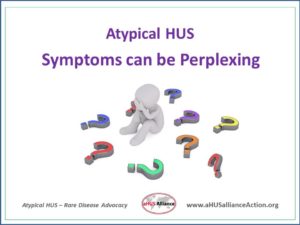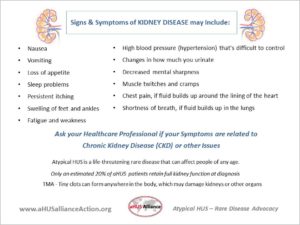
People living with the rare disease atypical hemolytic uremic syndrome (atypical HUS or aHUS) face many challenges, including the difficulty in speaking with their healthcare professionals about symptoms that are often vague and difficult to quantify. There is no single and definitive lab test1 for atypical HUS, and aHUS often a diagnosis of exclusion when physicians are trying to distinguish among the other diseases with similar symptoms. The medical and research communities are newly focused on differentiating thrombotic microangiopathies (TMAs) to diagnose atypical HUS, and in 2017 there began a movement toward multi-disciplinary medical teams2 to treat and manage the broad impact of damage that tiny blood clots can cause in small blood vessels anywhere in the body. The aHUS Alliance has offered past articles on the need for cross specialty care teams for aHUS patient management. But how can patients monitor their health, and what symptoms or body changes are important to report to your doctor?
Atypical HUS affects an estimated 2 people per million3, with episodes of aHUS activity occurring at any patient age and with different frequencies (acute episodes or chronic illness). Atypical HUS can cause damage to any organ or body system, not just kidneys, with about 20% of aHUS patients still retaining full kidney function at diagnosis4. Most commonly affected is the central nervous system (CNS) with serious issues such as stroke or seizure, heart (cardiac) problems, breathing or lung (pulmonary) issues, or health issues such as problems involving the skin, stomach or intestines (GI).5
At medical appointments, let your doctor know about changes in body function, habits, or abilities. Symptoms regarding changes in sleep, appetite, energy levels, or ability to concentrate that may seem vague or unimportant when taken individually may actually provide small clues to important insights when physicians take a holistic view of patient health. Why? Difficulty getting or staying asleep is a common issue for patients with chronic kidney disease (CKD), so that’s an important concern to voice at your medical appointment. While skin issues are not common for people living with atypical HUS, they have been documented. Pregnant women who are diagnosed with aHUS, and the physicians who monitor and treat them, should be especially vigilant. For atypical HUS patients of any age, complaints of fatigue might be related to low red blood cell counts common to aHUS and caused by hemolysis (red blood cells sheared and destroyed), but fatigue is also common when kidney function starts to fail (low GFR) and there are a whole host of other reasons why a person might feel tired. Eyes bothering you? It might be as simple as eye strain from computer screens, or blurred vision because you’ve neglected a visit to your eye care professional and need an updated eyeglass or contact lens prescription. Changes in vision may signal important changes in your health, and people living with atypical HUS need to be aware that eye health and vision can be impacted by aHUS activity. ‘Brain fog’ might offer a collective term to describe difficulty with focus, memory, or concentration for some aHUS patients and such issues have the ability to hinder performance and participation at school or work.
Changes in a person’s daily life may impact their ability to function, or might be related to something vague like increased headaches, loss of appetite, or changes in behavior. Symptoms of aHUS vary widely from patient to patient, along with frequency and severity of disease activity, adding emphasis to the term ‘atypical’ and providing a cautionary note against attempting comparison among aHUS patients’ medical situations. For problems big or small, easy to identify or likely to blame on daily stressors – keep track of concerns and mention them to your medical professionals. When taken together and combined with lab results or other quantitative testing, small issues can sometimes as red flags or arrows that point toward clinical clues that could allow physicians better management of the disease. What should aHUS patients and caregivers look for, and how can they keep track of symptoms to discuss with their medical team?
Here’s the aHUS Alliance Clinical Tracker, download to print:
Click: Clinical Tracker OR http://bit.ly/2Ai4bNX
![]()
Important Note: This guide includes only some of common symptoms experienced by many aHUS patients, and does not replace – but instead assists- the need to meet & talk with a medical care team. Only an aHUS patient’s own doctor, specialists, and medical support staff can offer medical information that’s appropriate for each specific patient with atypical HUS.
Time is precious. Time is money. Your health is your wealth. We’ve heard these old sayings for years, but they have added relevance for aHUS patients and their caregivers as well as for the medical personnel who treat them. Most healthcare professionals utilize electronic forms to record symptoms, which are an efficient way to track patient health issues, but are best formatted for recording common health issues. A collaborative effort is needed among stakeholders, with physicians, industry, and patient advocates addressing more effective communications and for both clinicians and patients. How are aHUS patients or caregivers for pediatric patients supposed to learn what symptoms to recognize and report? Much work remains to be done regarding how to improve patient education materials, and how to maximize the interface opportunities of patient – clinician interactions. Medical appointments sometimes seem too short to give an overview of what the patient is experiencing, and dedicated physicians may feel torn between demands of their practice and the need to offer detailed, highly specialized patient education. How can clinicians ask patients to be effective and concise in noting medical concerns that might indicate such complex areas as multi-organ involvement? While it all starts with accurate and comprehensive knowledge for both patients and medical personnel, sorting through vague and perplexing symptoms required dialogue to explore facts and try to pin down whether issues might be related to general life issues (diet, emotional or family stress), indicative of issues with a specific component of the patient’s treatment (dialysis, side effect of medicine), or related to an important change in patient health (decrease in kidney function, aHUS affecting organs other than the kidneys, or a health concern unrelated to aHUS). Especially within the rare disease arena, when so much is confusing, everything for patients should be developed with patients, to create a deeper dialogue about concerns, needs, and building pathways to continue the conversation.

aHUS Patients & the Need for Multidisciplinary Care
Click HERE to read the Article
L Burke March 2018
Citations:
1. FMI on this Topic See: Modified Ham Test Role of Skin Biopsy in Diagnosis of aHUS Evaluating Thrombotic Microangiopathy to Differentiate aHUS
2. Gordon CE et al. Thrombotic Microangiopathy: A Multidisciplinary Team Approach. American Journal of Kidney Diseases , Volume 70 , Issue 5 , 715 – 721. Nov 2017.
WATCH the Video: Co-author Dr Jean Francis on this topic. TMA Boston clinical presentation begins at 17:40, following aHUS Patient Experiences (reps from 3 nations: UK, US, CA).
3. Maga T et al. Mutations in alternative pathway complement proteins in American patients with atypical hemolytic uremic syndrome. Hum Mutat. 2010 Jun;31(6):E1445-60. doi: 10.1002/humu.21256.
4. DeYao J et al. An Atypical Case of Atypical Hemolytic Uremic Syndrome: Predominant Gastrointestinal Involvement, Intact Renal Function, and C5b-9 Deposition in Colon and Skin. J Hematol. 2015;4(3):193-195.
5. Hofer J et al. Extra-renal manifestations of complement-mediated thrombotic microangiopathies. Front. Pediatr., 08 September 2014 doi: 10.3389/fped.2014.00097.
Know the signs and symptoms of Kidney Disease
(Bullet points courtesy of the Mayo Clinic)

Learn MORE about Atypical HUS
Info & Resources – aHUS Information Centre

